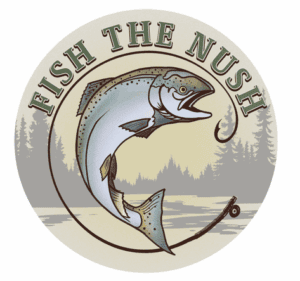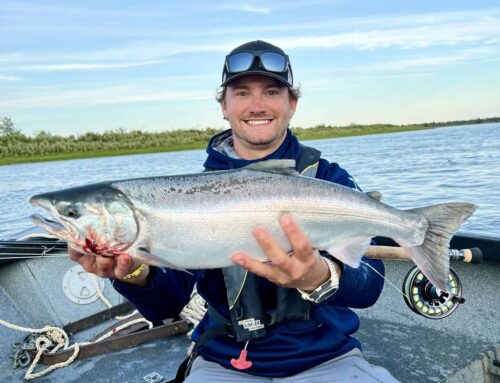Silver Fishing on The Nush: As seen in the December issue of Fish Alaska magazine.
Written by Melissa Norris
It’s no secret that the Nushagak River is the leading Chinook salmon fishery in Alaska, but far less known is that it’s a primary source of coho as well. The amazing part is that there is nearly no sport-angling pressure, making for the quiet wilderness experience many seek. Most of the tent camps and lodges pack up and head home after king season, but towards the end of the Chinook run, typically the latter half of July, silvers begin to show. One of the only outfitters we know that sticks around to fish silvers on the Nush’ is one of the best. Nushagak River Adventures Lodge is in full swing for silver season at their all-inclusive fishing lodge.
Silver fishing is exhilarating—chrome missiles execute acrobatic feats the likes of a Cirque du Soleil performer. Action and abundance are among the reasons people like to fish for silvers as well as their substantial size, fighting ability for their weight class, and the numerous tactics to entice them. In short, coho fishing is a blast. The end results are tasty fillets said to be the best salmon-species choice for certain culinary dishes.
What makes Alaska’s 5th largest river by water volume, the Nushagak, a good silver fishing destination? The sheer number of fish mixed with the limited amount of sport- and commercial-fishing pressure places it on another level. Ted Gibson has guided on the Naknek and the Nushagak during silver seasons. He likes that you might not see another boat during a day of coho fishing on The Nush’. Due to the close proximity to the river’s terminus at Bristol Bay, Ted notes that the silvers don’t really seem to mill around much in their section of the river, being close to the bay. When fish push in they are easy to spot but they don’t hang around too long. There may be more fish entering the river that day, but if not, you can fish to a group of silvers you find in one section and when the bite goes off, move to find them again further up around a couple bends.
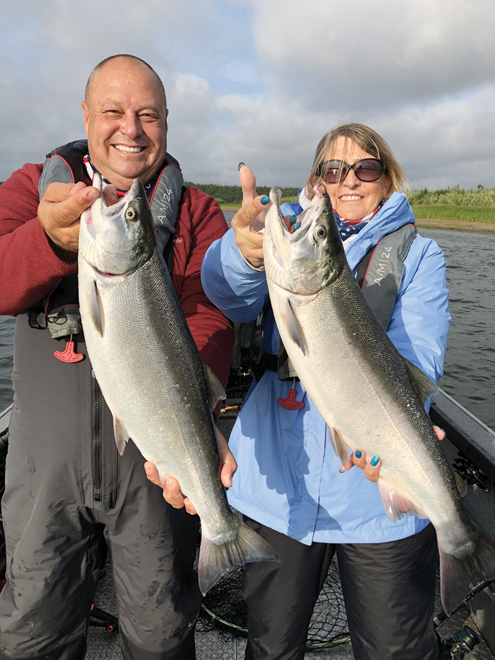 Lead guide Brent Seamans remembers the best week he’s ever had on the Nush’ was the last week in July about ten years ago. Everything aligned for their guests to catch big kings upriver in the morning and then move down in the afternoon to catch limits of silvers—the best part was there was virtually nobody around. At certain times during the silver and king crossover dates, guides like to downstream troll in the lower section of the river because you never know which it’s going to be when your line goes tight, a king or a silver. Historically, silvers start to show in the Nushagak in late July with the season well underway the first couple of weeks of August. A trend that is starting to appear in recent years is a later run. Still, the first coho are normally caught around the 20th of July with daily limits (currently five coho) obtainable by July 27.
Lead guide Brent Seamans remembers the best week he’s ever had on the Nush’ was the last week in July about ten years ago. Everything aligned for their guests to catch big kings upriver in the morning and then move down in the afternoon to catch limits of silvers—the best part was there was virtually nobody around. At certain times during the silver and king crossover dates, guides like to downstream troll in the lower section of the river because you never know which it’s going to be when your line goes tight, a king or a silver. Historically, silvers start to show in the Nushagak in late July with the season well underway the first couple of weeks of August. A trend that is starting to appear in recent years is a later run. Still, the first coho are normally caught around the 20th of July with daily limits (currently five coho) obtainable by July 27.
Different signs make coho presence known. Some are obvious like seeing fish literally jumping out of the water or “finning” at the surface. You will catch a flash of chrome at the top of the water column or hear those tails splashing. When silvers are in thick, Nushagak River Adventures Lodge’s guides will put clients on fish using a variety of tactics. One technique they apply, when it’s an option, is casting spinners and jigs from the bank, a fun and interactive method—for some even more so than sitting in the boat all day. If the silvers are not in abundance yet they’ll downstream troll with spinners from the boat to cover a lot of water. It is a good way to find silvers and pick some up. Sometimes there will be a bank nearby where you can cast to them once you find them downstream trolling. Silvers can sometimes be found resting in slack-water sloughs off the main channel. When they’re in there in numbers it is fun to cast a jig into this froggy water, retrieve it with a twitch, and watch the surface explode with silver bombs.
It’s not terribly difficult for avid anglers to catch coho when the fish are in, but like most fishing, timing is everything. If you happen to be there when the fish are stacked up then it’s easy to line up on a beach to cast spinning lures and jigs, then boat from beach to beach touring the river to find new groups of fish. Silvers tend to run between 10- and 40 feet offshore so flycasting to them is also an option.
Jigging is a favorite way to catch silvers for many seasoned salmon anglers. It’s guide Ted’s favorite way to fish silvers. Ted says for jigs he almost always uses bubble-gum pink, but sometimes he’ll add a little orange, purple, or white mixed in with more pink. The guides at Nushagak River Adventures Lodge make their own jigs using lead heads, rabbit and marabou for the natural movement it produces in the water. Depending on where silvers are found, Ted will have anglers either cast from the beach or will float the boat downriver close to the bank while anglers cast towards shore.
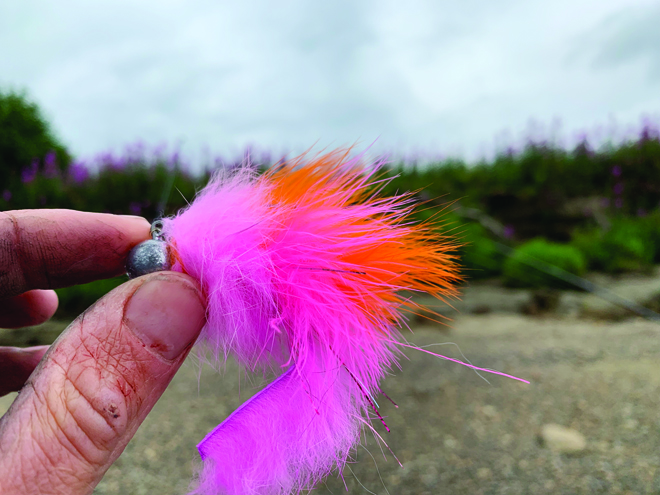 For silver fishing from the bank they use spinning rods with Penn Battle 4000-sized spinning reels. They are spooled with 15- or 20-pound Powerpro of which Ted prefers hi-vis white or yellow. Whether Ted is guiding practiced anglers or those new to the sport, he has them cast their jig straight across the current, just slightly upstream. He tells them to let the jig sink to the bottom, and then to give it a slight one-foot lift and let it back down. He doesn’t encourage a lot of reeling when it’s out in the current. The current will swing the jig downstream as you rhythmically give it a little twitch. Once you get to the slower water on the tail end of the drift there’s a good chance you’ll hook up to a torpedo of a fish. If not, then on the retrieve, pick up your reeling pace but add a “jig, jig, stop” cadence to your technique. Sometimes they’ll follow it right up to the bank and hit it there, with just enough jig movement to make a following fish hot enough to pounce on it.
For silver fishing from the bank they use spinning rods with Penn Battle 4000-sized spinning reels. They are spooled with 15- or 20-pound Powerpro of which Ted prefers hi-vis white or yellow. Whether Ted is guiding practiced anglers or those new to the sport, he has them cast their jig straight across the current, just slightly upstream. He tells them to let the jig sink to the bottom, and then to give it a slight one-foot lift and let it back down. He doesn’t encourage a lot of reeling when it’s out in the current. The current will swing the jig downstream as you rhythmically give it a little twitch. Once you get to the slower water on the tail end of the drift there’s a good chance you’ll hook up to a torpedo of a fish. If not, then on the retrieve, pick up your reeling pace but add a “jig, jig, stop” cadence to your technique. Sometimes they’ll follow it right up to the bank and hit it there, with just enough jig movement to make a following fish hot enough to pounce on it.
For less-experienced anglers, or if the jig isn’t working, Ted will switch it up to a #4 Vibrax spinner by Blue Fox, noting a color he finds effective on silvers is an orange body with a gold blade. He recalled that he rarely catches silvers on a chartreuse jig but he does on a chartreuse spinner. The jigs usually do the trick, but sometimes they just respond better to the spinning-blade action in the water. Key to spinner success is retrieving the lure at a medium speed, not too fast or slow, while letting it swing downstream. The bite can be less obvious for coho on artificial baits. If the spinner stops moving you want to set the hook. They can spit it out as fast as they take it, but the guides at NRAL are confident they can get even the most-novice angler their coho limit.
Sometimes they will use plugs too, and Ted mentioned he likes the Luhr Jensen K16 Kwikfish in the Double Trouble pattern or a Mag Wart, popular plugs among salmon fishermen for sure. The larger size mentioned sparked further conversation because that’s not the traditional choice for silver fishing. Ted attributes that tip to Kris Kallina who showed him the effectiveness. He has tried smaller plugs and they’ll catch fish, but the larger plugs seem to run better and also get down better. He’ll usually belly wrap a sardine fillet on them and it works stellar on coho.
If silvers haven’t shown in force yet, or the water conditions make things harder than normal, then your Nushagak River Adventures Lodge’ guide will employ some of the tricks up their sleeves. This time of year will yield various water temperatures and depth, slightly cooler weather, and more rain. One method Brent finds effective is backbouncing eggs. It’s dynamite in high water but it also works well in other conditions. He’ll drop an anchor with a buoy to get on the seam. He likes to put some yarn in his egg loop with some scent for an extra offering when a wily silver snatches the real glob of eggs. It’s a great option for folks who can’t cast well. One angler can still cast off the back of the boat when anchored. Sometimes you can run a single plug in that scenario too. After you’ve caught your daily limit, they’ll switch over to less-invasive tactics than backbouncing eggs for maximum catch-and-release success.
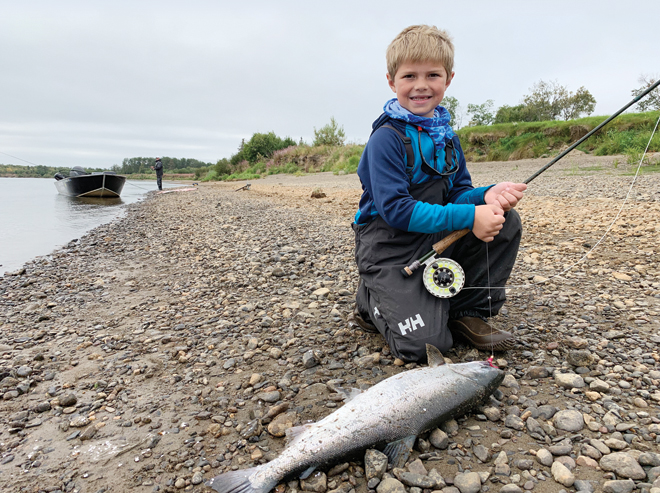 There are a number of ways to catch silvers, each effective in their own way. Sometimes you have to and other times you just want to change it up. Whatever style of silver fishing is working when you visit, the daily limit of silvers is five per angler and it’s routine for guests to fill a fifty-pound, airline-approved box to take home with them.
There are a number of ways to catch silvers, each effective in their own way. Sometimes you have to and other times you just want to change it up. Whatever style of silver fishing is working when you visit, the daily limit of silvers is five per angler and it’s routine for guests to fill a fifty-pound, airline-approved box to take home with them.
As far as remote river access in Alaska, the Nushagak is a relatively easy trip to make. It starts with thorough communication and planning from the lodge’s management and ends with an experience that was orchestrated as smoothly as one can hope for in a trip of this magnitude. This is a team that is dedicated and experienced and their collective goal is to make sure clients have a great time and stay safe. The fishing is served up exquisitely. The rest of the showing is significant too, from the brand-new buildings that have been erected after systematically demolishing the original dilapidated facility, to some of the best food I have ever been served thanks to Chef Chris Lee and the total commitment to excellence.
I have had the pleasure to visit many fishing lodges throughout Alaska in my 20-year career at Fish Alaska, including Nushagak River Adventures Lodge, and I can attest to the quality of the service these folks offer. I’ve watched the transformation over the last several years that their owner Pete von Jess has conducted with an exceptional group of guys as their construction team. Pete took ownership of NRAL in 2017 and has since spent an enormous amount of resources tearing it down and resurrecting a new, far-superior facility for guests to safely and comfortably enjoy their time on the Nush’. Read about their construction venture in the sidebar to this story.
If you are looking for an extraordinary silver salmon river in Alaska that doesn’t get too much pressure and provides that quiet wilderness experience you seek, the Nushagak River in Bristol Bay is a great choice. If you are looking for a fantastic lodge with amazing people, sensational food, and the nicest lodge facility available, then Nushagak River Adventures Lodge (fishthenush.com) is a tremendous choice.
The Resurrection
There is one word to describe what’s been done at Nushagak River Adventures Lodge these last few years—impressive. From the moment owner Pete von Jess took over in 2017 and surveyed the property with his buddies after a chilly snowmachine ride in from Portage Creek, everything was about to change. Pete was a guest of the lodge for several years, and when the business went into bankruptcy the guides called him to ask for help. He took that on with the same determination he puts into everything. When Pete eventually learned he would have to buy the lodge and property out of bankruptcy to see the guides get their wages from the season they had just completed, he did just that. One thing I’ve observed over the years working with this team is that everything is done well, so it shouldn’t come as a surprise to the people around them that once they started to make improvements, they wouldn’t stop until it was complete. That wasn’t the original plan, however.
The intention was to come in, clean up the property, and make it safe for guests to visit. A series of events led to adjustments in the build plan along the way. Pete wrote a great story telling the details of this amazing undertaking and highlights their decisions at pivotal moments. It is posted on their website blog at fishthenush.com/bristol-bay-lodge-revival. But what ultimately took place in four summers combined with the immeasurable winter planning and purchasing time is nearly unfathomable. Construction isn’t easy anywhere, but imagine what it’s like to have to truck and barge or fly all of the materials and supplies just to get it there. It’s an enormous project.
It certainly helps that they had a great group of people, comprised of family, friends and fishing guides, who happen to have all of the experience and skills to pull this off. In four short summers, mostly while clients were coming and going, the crew demolished the old property to replace it with nine guest cabins, a new main lodge, expansive staff dorm, and most recently a new bathhouse with both men’s and women’s separate facilities, each offering privacy and ample space for all of the guests and staff in camp.
Attention to detail, good taste, and quality building practices all led to this admirable outcome. As a grand finale they connected all of the cabins and buildings by walkway so clients can stay out of the mud in wet weather. They not only pulled it off…They crushed it.
The buildings aren’t the only facet of the upgrades over the years. During all of this Pete bought a new fleet of matching Alumaweld boats and motors for guests to fish from safely and comfortably. They replaced all of the king fishing gear with quality Daiwa Lexa line-counter reels, and Lamiglas Red Line rods. All new silver gear was purchased for 2020 too. Literally everything got upgraded. The fish-processing facility and capabilities were made ample. An all-new commercial kitchen was installed in the main lodge. They improved all of the lodge systems including solar power, internet, and water treatment. The main lodge itself is a comfortable dining facility with beautiful handcrafted square tables that each seat eight and are intended to be reconfigured based on the groups in camp during any given four-day, four-night session. It’s decorated with fish and game mounts and custom fireplaces and adorned with thoughtful gifts from friends. Seven cabins each sleep four; two more are available for two people each. The boats fish up to four comfortably.
It’s not just the property, boats and gear that was enhanced. There are certainly lodges out there where the fishing program is dialed in but the business or hospitality aspects are wanting. In this case they have it all figured out; the people have been a huge addition to the quality of the lodge. From Chef Chris who manages the kitchen and hospitality team and prepares some of the most delicious food you will ever try to their lead guide, Brent Seamans, who takes responsibility for the guide team to operate by lodge standards. It’s also the behind-the-scenes accounting and marketing people, not to mention the organization and communication from their leader, that make the entire operation steadily run well. Yup, it’s quite impressive.
Melissa Norris is founder and Publisher of Fish Alaska since inception in 2001, she is also the owner of Hunt Alaska. Traveling to fish across Alaska ranks high among her greatest pleasures.
